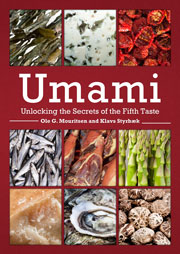In the West, we have identified four basic tastes—sour, sweet, salty, and bitter— that, through skillful combination and technique, create delicious foods. Yet in many parts of East Asia over the past century, a fifth taste—umami—has entered the culinary lexicon. Umami is savory, complex, and wholly distinct. Combining culinary history with research into the science, preparation, nutrition, and culture of food, this book encapsulates what we know to date about the concept of umami, which, when harnessed, enables us to become more intimate with the subtleties of human taste and make better food choices for ourselves and our families.
Umami [u:ma:mi]—Japanese expression for ‘the fifth taste’ coined by a Japanese chemist, Kikunae Ikeda, in 1909 in connection with his discovery of glutamate in the soup stock dashi. Umami (旨味 or うまみ) is derived from the Japanese adjective umai (旨い), which can be interpreted in two ways. One has hedonistic connotations, implying that a taste is delicious and pleasant. The second refers to the actual sensory aspect, that something tastes meaty and spicy. As neither of these meanings is specific only to glutamate and both can be applied to other substances as well, umai is not the same as the taste of glutamate. In order to differentiate between the two, Ikeda proposed a newly constructed word, umami, which combines umai with mi (味), which means ‘essence,’ ‘essential nature,’ or ‘taste.’ This is how the taste of glutamate came to be linked inseparably with umami. Today the definition of umami is considerably broader, as it is now known that this taste is not derived simply from glutamate. It can be imparted by two different but complementary substances, acting alone or in concert. A basal contribution comes from the presence of free glutamate, and a strengthening or synergistic contribution is due to 5’-ribonucleotides, especially inosinate and guanylate.
